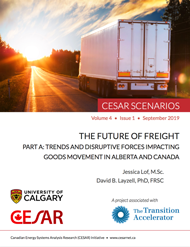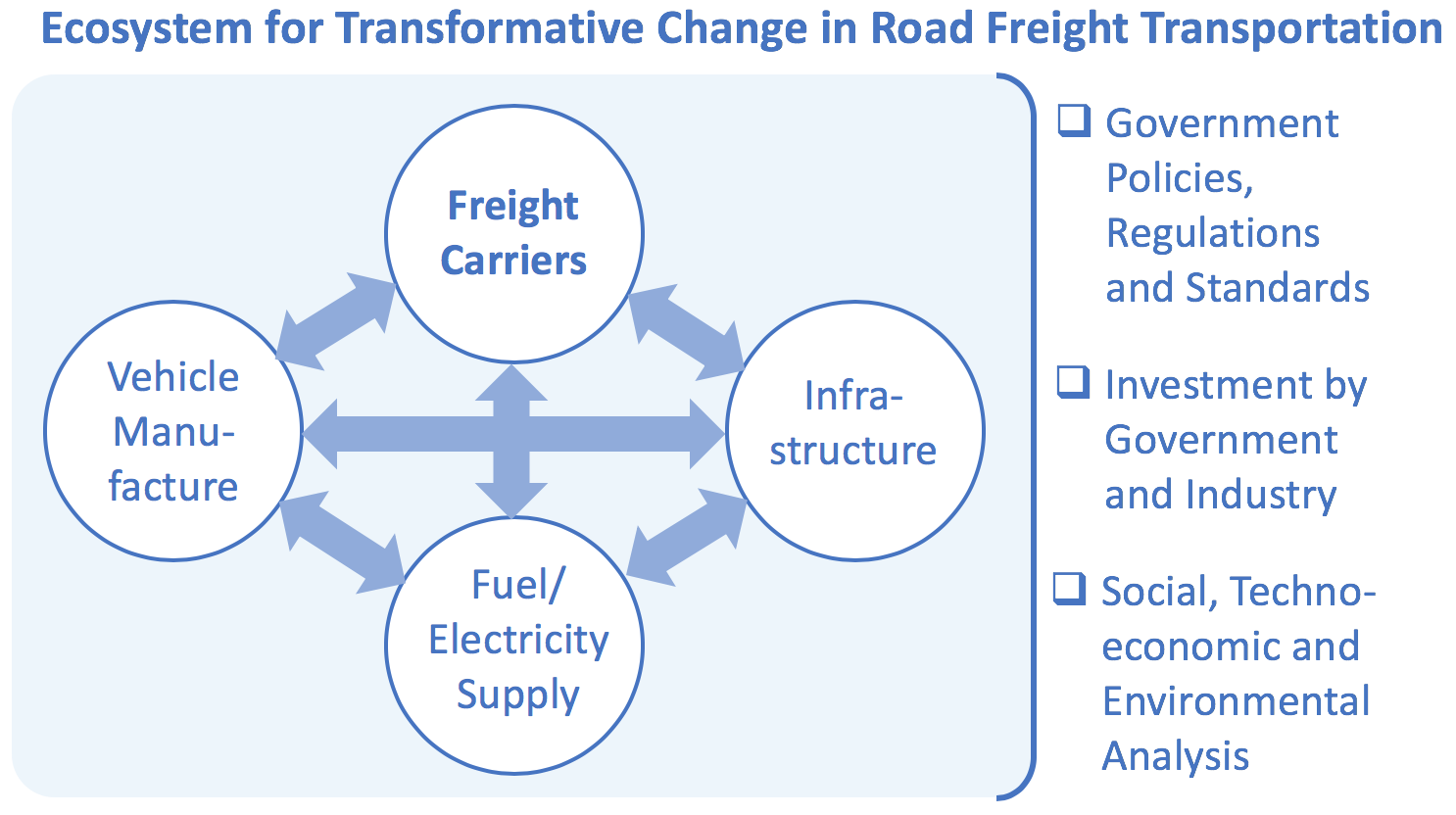Posted on Wed, 09/04/2019 - 06:01
By Jessica Lof MSc and David B. Layzell PhD, FRSC


Figure 1. Front cover of the new Future of Freight (Part A) report from CESAR. Click on the image to download.
The essential first step in this process is to gain a good understanding of the trends, challenges and disruptive forces impacting the sector. This allows for credible and compelling pathways to be envisioned that improve the sector at a systems-level while also reducing GHG emissions.
Canada’s road freight sector is large, including about 300,000 heavy duty vehicles that are either owned by companies moving their own goods, or by ‘for hire’ freight carriers. Demand in road freight has outstripped other sectors of the economy, growing by 97% between 1990 and 2016. Heavy duty diesel vehicle emissions are estimated to be about 47 Mt CO2e/year1, or about 157 t CO2e/vehicle/year. To reduce GHG emissions at a magnitude that is required to seriously address climate change, we need an alternative to fossil fuel-based diesel.
Sectoral Challenges
Changing the fuel supporting freight transport is a tall order, so defining a transition pathway would benefit from a deeper understanding of the system needing change in the hope of identifying possible synergies. The report documents the many challenges facing the freight sector today, including:
- Driver shortages, as younger people are not attracted to the sector2. Driver demand is expected to exceed supply by ~35,000 drivers by 20243;
- Poor load factors, resulting from empty back-hauls and less than optimal loads;
- Inefficiencies resulting from congestion, delays at loading/unloading docks or at border crossings, and restrictions on the hours that drivers can work per day;
- Accidents, frequently linked to driver fatigue or inadequate driver training;
- Air pollution and greenhouse gas emissions that are increasingly leading to cities, regions or countries announcing bans on either diesel or all internal combustion engines by 2030 or 20404;
- High operating costs, with labour and fuel costs accounting for over 50% of the total;
- A fragmented industry, resulting, in part, from too many companies and a culture of mistrust.
Disruptive Forces
Many in the trucking industry are eager for change, and they watch with interest, or are working with companies developing innovations that could disrupt the sector and improve their competitiveness. These disruptive forces include:
- E-commerce, the buying and selling of goods though the internet, undermining traditional retail and increasing the movement of goods on trucks. This trend is expected to continue.
- Battery electric tractors (e.g. Tesla Semi), where the electricity supply is from the public grid;
- Hydrogen fuel cell electric hybrid tractors (e.g. Nikola motors), where the electricity is generated from hydrogen stored on board the vehicles;
- Autonomous, connected vehicles capable of platooning5 on major highways, or navigating routes without drivers;
- Collaborative Transportation Management (e.g. Uber Freight), that uses digital platforms to optimize loads and speed goods movement;
- Physical Internet6, a new, highly efficient supply chain logistics network where boxes are like bytes moving through the digital internet;
- Drones7, hyperloops8 and other innovative technologies for moving freight.
From the perspective of wanting to accelerate the transition to a low carbon economy, the electrification of the drivetrain with zero or very low carbon power sources (battery electric or hydrogen fuel cell electric) are the most important innovations on this list and are already highly compelling to many in the industry. They are attracted by the lower emissions, lower noise, fewer moving parts (lower maintenance) and greater torque that these vehicles promise.
“the freight transportation sector has a strong desire to be in charge of its destiny and the sector has the will to lead transformative change”
Nevertheless, to make electric drivetrains more compelling, they could be combined with other innovations, like vehicle autonomy -that should dramatically improve the economics and competitiveness of the freight carrier.
In doing the research for this report, we learned that the freight transportation sector has a strong desire to be in charge of its destiny and the sector has the will to lead transformative change, including the movement to a low carbon economy.
Transforming Freight is Bigger than the Freight Sector
It is also important to recognize that while the freight carriers may be the ‘key stakeholder’ in the freight sector’s shift to a low carbon economy, other industry and government sectors are essential in realizing transformative change in freight movement. As shown in Figure 2, these include the vehicle manufacturers, fuel or electricity providers, and infrastructure providers.
Clearly, to shift the freight sector to a low carbon economy, other major sectors will need to be considered if we are to define a credible, compelling and capable transition pathway that will achieve societal objectives.

Figure 2. The ecosystem for transformative change in road freight transportation
In addition, policy makers will need to implement enabling policies/regulations/standards. Government and industry will need to make significant new investments across all impacted sectors, and academia and consultants can contribute by providing social and techno-economic and environmental assessments of various futures to ensure that the pathways taken are most likely to lead to societal benefits while avoiding undesirable, unintended consequences.
CESAR is working on two more reports in our Future of Freight Series. The next report in the series analyzes the energy requirements of hydrogen fuel cell and battery electric trucking compared to the current diesel and bio-based diesel systems. All are evaluated based on the alternatives fit for service. The last report looks at the opportunity for Alberta to remain in the transportation fuel business in a low carbon future.
Acknowledgement
Having made this work possible, CESAR greatly appreciates the support of Alberta Innovates and the charitable foundations that have contributed to the launch of the Transition Accelerator, including the Edmonton Community Foundation, the Ivey Foundation and the Clean Economy Fund.
Footnotes
1 Environment and Climate Change Canada, “National Inventory Report 1990–2016: Greenhouse Gas Sources and Sinks in Canada,” Apr. 2018 [Online]. Available: https://www.canada.ca/en/environment-climate-change/services/climate-change/greenhouse-gas-emissions/inventory.html
2 https://amp-businessinsider-com.cdn.ampproject.org/c/s/amp.businessinsider.com/truck-drivers-reveal-the-worst-parts-of-their-jobs-2019-8
3 CPCS, “The Truck Driver Supply and Demand Gap Final Report,” 2016 [Online]. Available: http://www.drivershortage.ca/wp-content/uploads/2017/01/Update-2016-%E2%80%93-Truck-driver-Supply-and-Demand-Gap-CPCS-Final-Report.pdf
4 I. Burch and J. Gilchrist, “Survey of Global Activity to Phase Out Internal Combustion Engine Vehicles,” Center for Climate Protection, Sep. 2018 [Online]. Available: https://climateprotection.org/wp-content/uploads/2018/10/Survey-on-Global-Activities-to-Phase-Out-ICE-Vehicles-FINAL-Oct-3-2018.pdf
